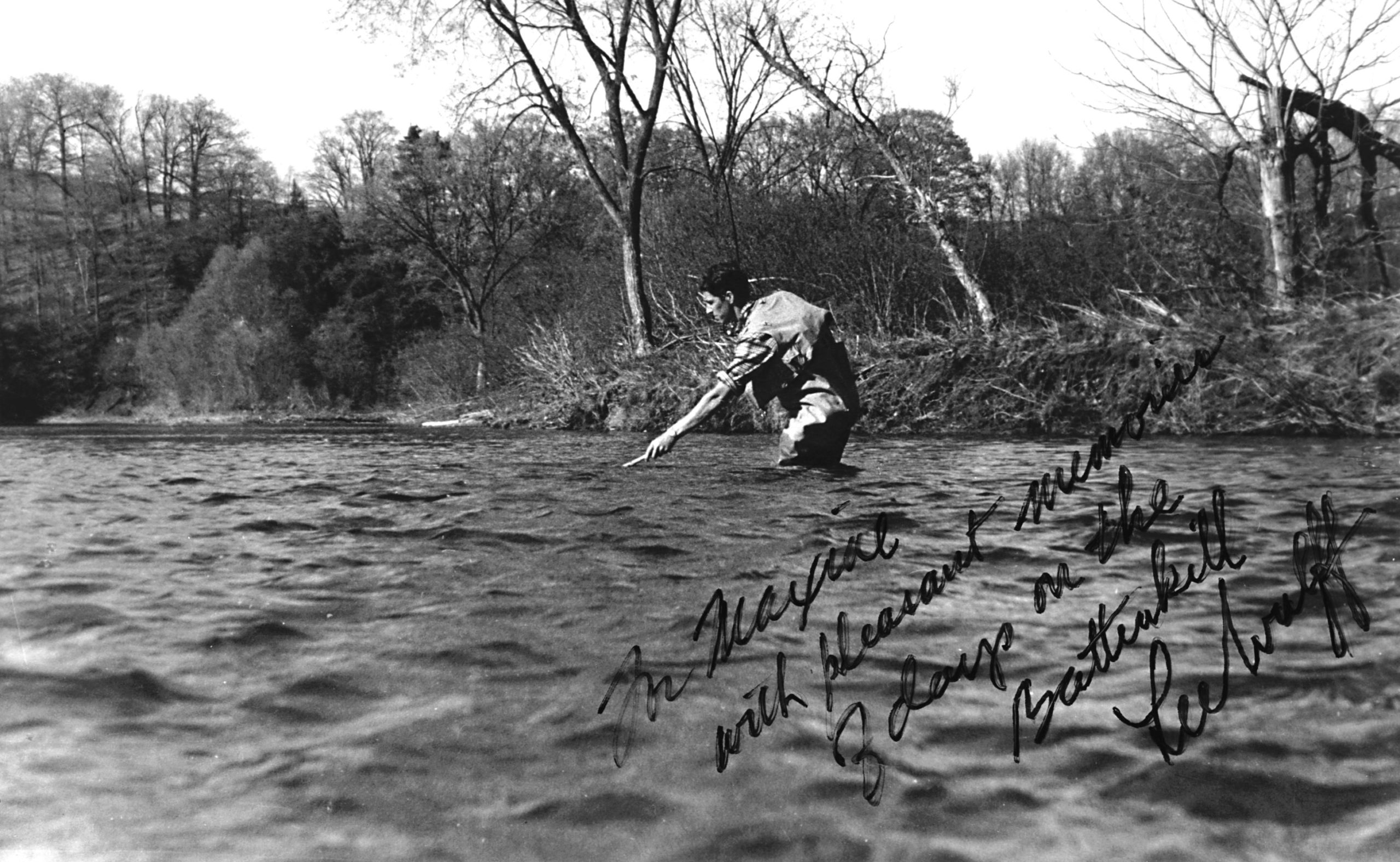By Peter Nardini

Lee Wulff reaches to land a trout in this photograph that he delivered to one of his longtime fishing partners on the Batten Kill, Maxine Atherton.
Izaak Walton once said, “Angling may be said to be so much like the Mathematicks, that it can ne’r be fully learnt.”1 He would have done just fine on the Batten Kill.
Much like high school calculus, fly fishing the Batten Kill in Manchester, Vermont, is challenging and requires gratuitous study. In fact, according to author John Merwin, the Batten Kill “might just be the most technically difficult fly-fishing stream in America. . . . Some fly fishermen will resent my having said this; most Battenkill veterans will agree with it.”2 The river tests even the most avid angler’s skill and patience, draining whatever sanity is left after a day’s work and perhaps a previous night’s fly tying in hopes of enticing a fish. The Batten Kill’s wily trout are doctorate scholars in discerning the tied fly from a real meal, to the point that one wonders how the river’s famous brown trout get so big by not eating. A lackadaisical cast or the usual clunky misstep in waders can spell doom to one’s chances for the day. Even when one drops in the perfect cast or manages not to disturb the crystal-clear water, the food is scarce and the fish-per-mile ratio slim.
All of these endearing features are part of what attracts the best of the best to experience the Batten Kill. It is a veritable outdoor hall of fame where the sport’s legends are honored with pools instead of plaques. Wulff’s Pool, named after perhaps the best fly fisher the river has seen, fell on hard times in the early 2000s.3 The river channel had become overwidened and shallow, and a flood channel was cutting off an important meander. Before the famed fishing hole was lost forever, the Clearwater and Adirondack Trout Unlimited chapters, the U.S. Fish and Wildlife Service, and the Batten Kill Watershed Alliance swooped to the rescue. Using backhoes and other heavy equipment, they installed a series of rock vanes to preserve the meander by redirecting the main force of the flow and recreating Lee Wulff’s favorite pool. In the decade since, the structures have functioned properly and have withstood a battering from Hurricane Irene (2011) and numerous other rain and snow events, proof positive of a job well done. Even though it did not occur during spawning season, Hurricane Irene still could have been catastrophic to the Batten Kill’s recovering wild trout population had there not been years worth of structure already in place to stabilize and maintain their habitat.
In 2006, the Batten Kill Watershed Alliance initiated a program that proved critical to preventing major loss of property and riparian habitat during Irene. A group of workers planted trees along the riverbanks to displace runoff water and keep it from flowing freely across wetlands and into public property. In a report on the post-Irene state of the Batten Kill, Vermont Fish and Wildlife biologist Ken Cox noted that “the new concrete arch bridge that replaced two old undersized culverts on Benedict Hollow Brook . . . designed to provide trout access to spawning habitat came through the flood fine and conducted water and any debris downstream without incident.”4
April showers may bring May flowers elsewhere, but in Manchester it brings trout. As is a long-standing tradition, anglers awake from their off-season hibernation, cast aside their fly-tying vises, and flock to the Batten Kill’s hallowed grounds to ply their trade once again. So as you take part in the opening-day rush and maybe find a fish or two, just stop, take a moment, and appreciate the hard work that some really good people have done to keep the river running.
Tight lines and safe wading this season!
Endnotes
- Izaak Walton and Charles Cotton, The Compleat Angler, ed. John Buxton (New York: Oxford University Press, 2009), 7.
- John Merwin, The Battenkill: An Intimate Portrait of a Great Trout River: Its History, People, and Fishing Possibilities (New York: Lyons & Burford Publishers, 1993), 156.
- For more information on the Wulff’s Pool project, see Batten Kill Watershed Alliance, www.battenkillalliance.org/projects/wulff’s-pool-shushan-2002. Accessed 15 January 2015.
- Ken Cox, quoted in Phil Monahan, “Hurricane Irene Update: Good News for the Battenkill,” Orvis News (19 September 2011), www.orvis.com/news/fly-fishing/Good-News-for-The-Battenkill-Post -Irene/. Accessed 15 January 2015.

